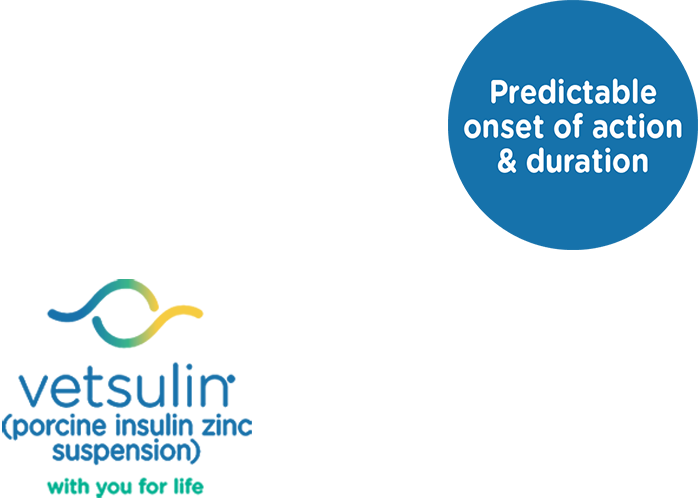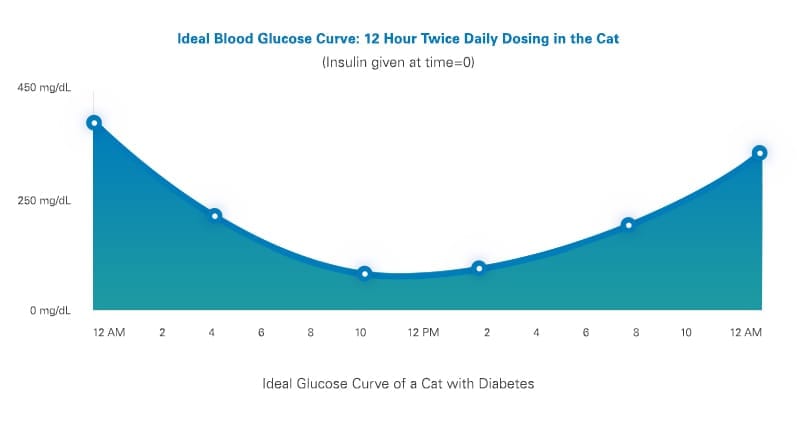

Glucose Curves

Vetsulin® For Life –
Diabetes Vet Nurse Program
Sign up today for this eBook series that helps veterinary nurses
and technicians work with pet parents to manage pet diabetes.
Read More About Monitoring & Controlling Feline Diabetes
The Glucose Curve
The glucose curve is a great tool to differentiate between an insufficient insulin dose and the Somogyi effect. It helps to determine insulin effectiveness and the maximum and minimum levels of glycemia, which ideally should be between 120–300 mg/dL (5.6–16.7mmol/L) for cats for most of the day.8 Try our online glucose curve generator.
Veterinarians commonly adjust the insulin dose based on a blood glucose curve. When creating a glucose curve, remember that stress can affect the reliability of results, and the glucose curve is only one tool among others that can help diagnose and monitor diabetes mellitus. Take clinical signs (or lack thereof) into account when contemplating any change in the insulin therapy. The ultimate goal in regulating a cat with diabetes is to control the clinical signs adequately so that the patient enjoys a good quality of life.
How to Complete a Glucose Curve
Feed and inject the cat with Vetsulin® (porcine insulin zinc suspension) as it is done at home. This may be done by the owner and then verified by the veterinarian. If the cat exercises at home during the day, the same exercise routine should be adhered to while the cat is in the hospital.
Blood sampling:
- Just prior to insulin administration (or immediately upon arrival, if injection occurs prior to clinic opening).
- Then, in at least 60 to 120 minute intervals. Glucose monitoring should occur hourly if glucose is in a range where hypoglycemia is a concern.
- Over a period of 12 hours, if product administered every 12 hours. This should ideally be done for 24 hours, particularly if product administered once daily.
How to Interpret a Glucose Curve
The aim of treatment is to alleviate clinical signs of diabetes. To achieve this goal, keep blood glucose concentrations below the renal threshold and avoid hypoglycemia. Thus, the goal is to maintain blood glucose concentrations roughly between 120 to 300 mg/dL in cats for the majority of the day.8
The duration of insulin action is measured from the time of Vetsulin® (porcine insulin zinc suspension) injection, followed by a fall in blood glucose concentration, to the time that blood glucose exceeds the renal threshold concentration of 200 to 280 mg/dL in cats. Because the added factor of stress can falsely increase the blood glucose values, the goal is to keep the blood glucose between 120 and 300 mg/dL for the majority of the day in cats. For twice-daily Vetsulin treatment to be effective, the duration of insulin activity following each injection needs to reach 10 to 12 hours.
Measuring Blood Glucose
Blood samples can be taken to measure blood glucose or blood insulin concentrations. Two methods of taking blood samples to produce glucose curves include:
- Collect a drop of capillary blood from the pinna and analyze it using a handheld glucometer.
- Glucometers should be calibrated specifically for dogs and cats because of the difference in the ratios of glucose in plasma and red blood cells from humans.
- Readings may vary as much as 15% from samples submitted to the laboratory.
- Handheld meters are reasonably accurate. If a reading seems unusual or does not match the clinical signs, a second reading should be taken or another method used to confirm the blood glucose measurement.
- Collect a venous blood sample from a peripheral vein. Plasma glucose concentrations are measured in the laboratory—the gold standard—or by an in-clinic analyzer.
Goals of Management
Consider treatment successful when the clinical signs of diabetes mellitus improve without inducing hypoglycemia.
Routine Re-checks
After the cat stabilizes successfully, perform routine re-checks every 2 to 4 months. Careful monitoring and control during maintenance will help to limit the long-term complications.
Blood Glucose Concentrations
The aim of therapy is not to produce a series of blood glucose concentrations that are within the reference range, but to produce a blood glucose curve that approaches the reference range and avoids potentially fatal hypoglycemia. A stable cats with diabetes exhibits a blood glucose range of around 120 to 300 mg/dL for most of a 24-hour period.
The graph below demonstrates an ideal blood glucose curve for a cat receiving Vetsulin twice daily.
Ideal feline blood glucose curve – Blood glucose measured in mg/dL

Vetsulin administered at 8 am to cat with diabetes.
Not all blood glucose curves will be ideal at first. For examples of additional blood glucose curve results, please select one of the following:
Resources to Help Clients Monitor Care
Help Your Practice Manage Diabetes Mellitus
Check out these tools and resources to help manage feline diabetes.

Blood Glucose Curve Generator
Create a blood glucose curve to monitor and evaluate diabetes treatments.

Client Discharge Form
Create a customized, printable form for clients about their new diagnosis.

Diabetes Resources
Access online tools and more to support staff and pet parents.
No items to show.
Read More About Monitoring & Controlling Feline Diabetes
Important Safety Information:
Vetsulin® should not be used in dogs known to have a systemic allergy to pork or pork products. Vetsulin is contraindicated during periods of hypoglycemia. Keep out of reach of children. As with all insulin products, careful patient monitoring for hypoglycemia and hyperglycemia is essential to attain and maintain adequate glycemic control and prevent associated complications. Overdosage can result in profound hypoglycemia and death. The safety and effectiveness of Vetsulin in puppies, breeding, pregnant, and lactating dogs has not been evaluated. See package insert for full information regarding contraindications, warnings, and precautions.
References:
1. Martin GJ, Rand JS. Pharmacology of a 40 IU/ml porcine lente insulin preparation in diabetic cats: findings during the first week and after 5 or 9 weeks of therapy. J Feline Med Surg. 2001;3(1):23–30. 2. Vetsulin® (porcine insulin zinc suspension) [Freedom of Information Summary]. Millsboro, DE: Intervet Inc.; 2008. 3. Data on file, Merck Animal Health. 4. Graham PA, Nash AS, McKellar QA. Pharmacokinetics of porcine insulin zinc suspension in diabetic dogs. J Small Anim Pract. 1997;38(10):434–438. 5. Martin GJ, Rand JS. Pharmacokinetic and Pharmacodynamic Study of Caninsulin in Cats with Diabetes Mellitus. 2000: Internal Study Report. 6. Feldman EC, Nelson RW. Canine and Feline Endocrinology and Reproduction. 3rd ed. St. Louis, MO: Saunders; 2004:539–579. 7. Tennant B, ed. BSAVA Small Animal Formulary. 4th ed. Gloucestershire, UK: British Small Animal Veterinary Association; 2002. 8. Feldman EC, Nelson RW. Canine and Feline Endocrinology and Reproduction. 3rd ed. St. Louis, MO: Saunders; 2004:486–538. 9. Reusch C. Feline diabetes mellitus. In: Ettinger SJ, Feldman EC, eds. Textbook of Veterinary Internal Medicine. 7th ed. St. Louis, MO: Saunders; 2010:1796–1816. 10. Nelson RW. Canine diabetes mellitus. In: Ettinger SJ, Feldman EC, eds. Textbook of Veterinary Internal Medicine. 7th ed. St. Louis, MO: Saunders; 2010:1782–1796. 11. Burgaud S, Riant S, Piau N. Comparative laboratory evaluation of dose delivery using a veterinary insulin pen. In: Proceedings of the WSAVA/FECAVA/BSAVA congress; 12–15 April 2012; Birmingham, UK. Abstract 121. 12. Burgaud S, Guillot R, Harnois-Milon G. Clinical evaluation of a veterinary insulin pen in diabetic dogs. In: Proceedings of the WSAVA/ FECAVA/BSAVA congress; 12–15 April 2012; Birmingham, UK. Abstract 122. 13. Burgaud S, Guillot R, Harnois-Milon G. Clinical evaluation of a veterinary insulin pen in diabetic cats. In: Proceedings of the WSAVA/FECAVA/BSAVA congress; 12–15 April 2012; Birmingham, UK. Abstract 45. 14. Davison LJ, Walding B, Herrtage ME, Catchpole B. Anti-insulin antibodies in diabetic dogs before and after treatment with different insulin preparations. J Vet Intern Med. 2008;22:1317-1325. 15. Banfield State of Pet Health 2016 Report. p 12-13
